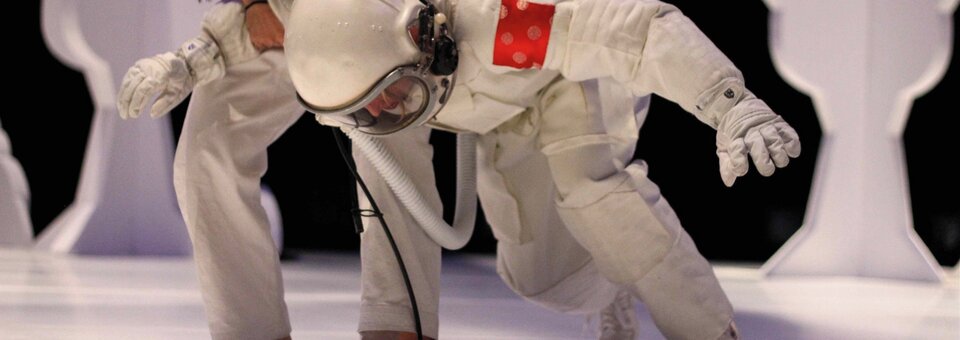
Concept/choreography: Francesco Scavetta
Created by and with: Gry Kipperberg, Orfee Schuijt, Soile Voima/Kim Ceysens
Music composed and performed by: Kim Myhr
Sound engineer and surround effects: Antonino Chiaramonte
Light design: Stefano Stacchini
Costumes and scenography assistant: Gjøril Bjercke Sæther
Scenography and video: Francesco Scavetta
Scenography realised by: Per-Anders Karlsson
Chinese translation and voice: Marcia Liu
Violin: Kari Rønnekleiv
Photos by: Marit Anna Evanger
Production leader: Gry Kipperberg
Production: Wee
Co-production: Dansens Hus, Oslo (Norway)
In collaboration with: the Cultural Centre Cap Vermell and The Quanta Art Project (Spain), Circuit-Est/Montreal (Canada), Vitlycke – Centre for performing arts/Tanumshede (Sweden), Tanzquartier/Vienna (Austria)
Supported by: Arts Council Norway, Fund for sound and image, Fund for performing artists, UD/DTS
- 18. May 2015 Ramallah (Palestina)
- 15. May 2015 Jerusalem (Palestina)
- 10. Oct 2014 Tanumshede (Sweden)
- 29. Sep 2014 Tanumshede (Sweden)
- 19. Mar 2013 Oslo (Norway)
- 09. Mar 2013 Tanumshede (Sweden)
- 14. Jan 2013 Canada
- 11. Jan 2013 Tanumshede/Sweden
- 10. Jan 2013 Tanumshede/Sweden
- 09. Jan 2013 Tanumshede/Sweden
- 08. Jan 2013 Tanumshede/Sweden
- 07. Jan 2013 Tanumshede/Sweden
- 06. Jan 2013 Tanumshede/Sweden
- 05. Jan 2013 Tanumshede/Sweden
- 04. Jan 2013 Tanumshede/Sweden
- 03. Jan 2013 Tanumshede/Sweden
- 19. Nov 2012 Tanumshede/Sweden
- 15. Sep 2012 Vienna (Austria)
- 10. Sep 2012 Residency at TQW/Vienna
- 20. Aug 2012 Residency at Tanumshe...
“On the moon and the day after” is built around absurd and surreal situations, with a flow that permeates and binds the elements together, albeit in a subtle and paradoxical way. We find ourselves in a white space that slightly suggest a urban landscape. A dreamlike atmosphere, with cinematic science fiction references, where the tension plays between dark humor and poetical non-sense. This loads of distillated situations invites us to examine how we relate to, and discriminate between, personal and impersonal, natural and constructed.
A white inflatable car, model 128 Fiat
A white helmet part of an astronaut costume
A white unreal landscape shaped also by a surround sound
A few white trees and 18 white stones
2 tape players and a few more objects
We are landing, we landed, we are here, you can see me
We are back
The core of the research within Wee’s productions has always been to deal with fragility and paradox, epiphany and dream, empathy and surprise, avoiding narrative and physical cliché, questioning reality and identity with humoristic disbelief.
In “On the moon and the day after” we find ourselves in a strange white urban landscape.
A dreamlike atmosphere, with cinematic science fiction references, where the tension plays between dark humor and poetical nonsense.
After the Surprised body project (2010>ongoing), which focuses on a research that see the body and the movement as its central element, with “On the moon and the days after”, Wee returned to work on a project where the physicality exists on the same level, and with equivalent valor, with text, theatrical action, conceptual situations, visual art and sound installations.
The show is built around absurd and surreal situations, with a flow that permeates and binds the elements together, albeit in a subtle and paradoxical way. This loads of distillated situations invites us to examine how we relate to, and discriminate between, personal and impersonal, natural and constructed.
Choosing visual and conceptual misplacement as a formal principle, “On the moon” exploits conventions and codes of representations of reality. With a process of adding and removing, elements and sounds, we play with the collapsing of the sense of the situations presented to us. We challenge audience’s expectations by asking them to complete the images presented with their personal imagination/associations. In this way, the performance invites to focus on how different levels of communication sinks in our own perception, opening for a process of recognition and awareness. It’s like the viewer is invited to look at something that strives to be there, but instead seems to lack the one thing that can explain why it’s there.
“In scores of science fiction stories, hapless adventurers find themselves unwittingly introduced to
the vacuum of space without proper protection. The ill-fated adventurers rapidly swell like
over-inflated balloons, ultimately bursting in a gruesome spray of blood” (by Alan Bellows)
As is true with many subjects, this representation in popular culture does not reflect the reality of
exposure to outer space, but the perception of an unnatural accident can be used as metaphor, in order to isolate a key situation, that, by being unusual, might challenge our daily perception of the reality.
“I fund the performances beautiful, hypnotic… you could feel the weight and the lack of weigh. And so many small details. It was so carefully worked out and I lost the feeling of time… something like that!”
(an audience’s comment on the show)





